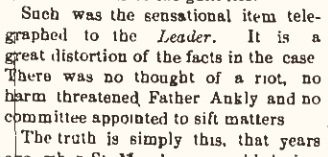Conclusion
The newspapers of the nineteenth century were the keystone to the Wooster community. They offered a connection to the world beyond Wooster but also a thread of local news and events. It is that desire to provide the local community that carries through to the Wooster Daily Record today. The Daily Record is actually the direct descendant of the Wooster Republican. In 1898, the Dix family bought the Wooster Republican and merged it with the Daily News to create the Daily Record.1 The Dix family ran the paper for five generations.
Andrew Dix, recently retired, reflected on connections between the paper and the Wooster community. “Our family felt it was important to live within the communities we covered. It kept us very connected to our community… No local story was unimportant.”2

Local newspapers continue to play a fundamental community role, but the twenty-first century brings new challenges and responsibilities for local papers. In 2017, The Daily Record changed hands from Dix Communications to Gatehouse Media. Gatehouse Media then merged with Gannett Company in late 2019, making The Daily Record a Gannett newspaper.3 Michael Shearer, the Regional Editor of Northern Ohio for Gannett, characterized the role of local newspapers as “a blend of cheerleaders for the community, but also watchdogs for the community.”4 In the age of social media, information spreads faster than ever before. Instead of being delivered on a weekly basis, news surrounds community members constantly. “Newspapers aren’t the gatekeepers anymore,” said Shearer. But information spread online is not always trustworthy and is very rarely unbiased. In the twenty first century, local newspapers have stepped up as sources of reliable news and factual reporting in the face of online misinformation.

Local newspapers serving as bastions against misinformation is hardly new. One article, printed in 1880 by the Cleveland Leader, reported that two Catholic graveyards in Wooster had been desecrated and that a riot was imminent. The Wayne County Democrat coldly described the story as “sensational” and charged that it was “a great distortion of the facts of the case.”5 The story had originated with a telegraph. Today, cell phones and social media have replaced telegraphs as sources of unreliable information. Stories today spread faster and further than nineteenth century readers would have ever dreamed. And local newspapers are often on the front line to combat them.
The function of newspapers has shifted in the past two hundred years. In the late nineteenth century, newspapers served as sources of political engagement and entertainment. Now, local newspapers are still rooted in the communities they serve. Although print readership is down, digital readership is up, and newspapers can reach more readers than ever before. In the modern era of heightened partisanship, social division, and misinformation, local newspapers are rallying points. They report on local news, “cheerlead” community members and initiatives, all while strenuously working to disseminate accurate, well-researched information to the public. Local newspapers continue to serve as forums for community engagement and, perhaps more crucially than ever, sources of truth.
Footnotes:
1: Paul Locher, When Wayne Was A Whippersnapper, (Carlisle Printing 2012; Daily Record, Wooster OH)
2: Andrew Dix, former Publisher of the Wooster Daily Record, in an interview with Georgina Tierney, June 9, 2020.
3: Tracy, Marc. “Gannett, Now Largest U.S. Newspaper Chain, Targets ‘Inefficiencies,” New York Times, November 19, 2019.
4: Michael Shearer, Editor of the Akron Beacon Journal, in an interview with Georgina Tierney, June 19, 2020.
5: ”Alleged Desecration of the Catholic Graveyard” Wayne County Democrat, May 5, 1880, 3.

